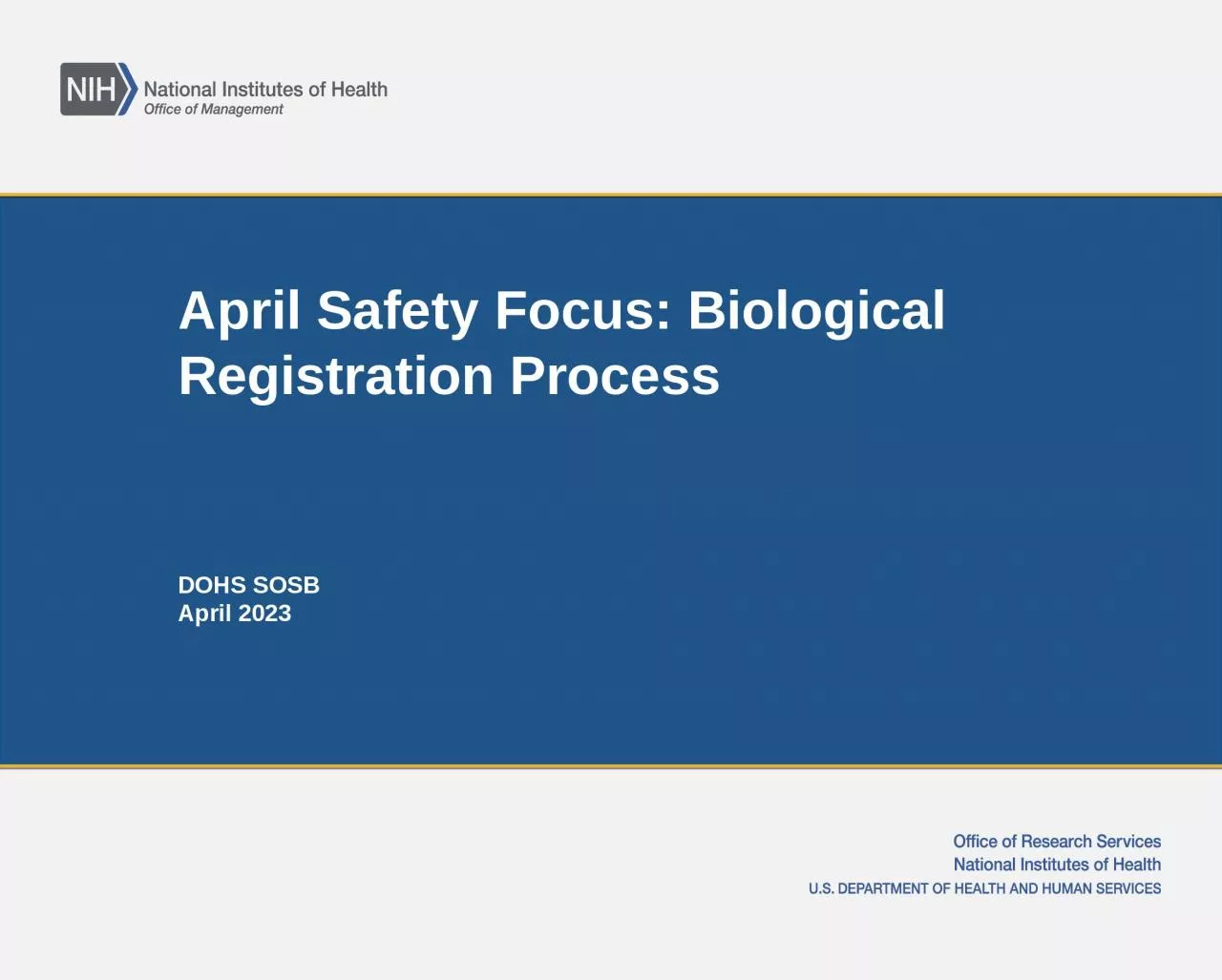

DOHS SOSB April 2023 Administrative Controls ALL work with biological materials toxins and recombinant DNA must be registered using PI Dashboard httpspolicymanualnihgov3035 The NIH Biorisk ID: 1033165
Download Presentation The PPT/PDF document "April Safety Focus: Biological Registrat..." is the property of its rightful owner. Permission is granted to download and print the materials on this web site for personal, non-commercial use only, and to display it on your personal computer provided you do not modify the materials and that you retain all copyright notices contained in the materials. By downloading content from our website, you accept the terms of this agreement.
1. April Safety Focus: Biological Registration ProcessDOHS SOSBApril 2023
2. Administrative ControlsALL work with biological materials, toxins and recombinant DNA must be registered using PI Dashboardhttps://policymanual.nih.gov/3035The NIH Biorisk Management Program ensures complianceNIH Guidelines for Research Involving Recombinant and Synthetic Nucleic AcidsInformation: https://osp.od.nih.gov/policies/biosafety-and-biosecurity-policy#tab2/Download: https://osp.od.nih.gov/wp-content/uploads/NIH_Guidelines.pdf 2
3. Administrative ControlsAll Principal Investigators (PIs) must register the following work with the NIH Institutional Biosafety Committee (IBC) Creating, manipulating or using recombinant or synthetic nucleic acid molecules covered under the NIH Guidelines (incl. transfected/transduced cells of any type)Involving agents infectious to humans, animals, and/or plantsInvolving human and non-human primate blood, body fluids, tissues (primary and established)Other potentially infectious biological material
4. Work with Toxins and Select ToxinsFor Select Agent/Toxin Associated Registrations:Contact the NIH Biological Safety Officer (BSO), SOSB or the NIH Select Agent Program (SAP) to receive additional instructions for review by the IBC and Select Agent Program registration. NIH policy requires registration for any work with acute toxins (LD50 = 100 µg/kg body weight)If a select toxin is possessed over the exempted amount, it must be registered with the Select Agent Program.NIH SAP: 301-496-2960 https://www.selectagents.gov/
5. Permissible Select Toxin AmountsPermissible Toxin Amounts, Federal Select Agent ProgramThe following toxins are not regulated if the amount does not exceed, at any time, the amounts indicated in the table below; however, registration is still required for these toxins. HHS Toxins [42CFR73.3(d)(7)]AmountAbrin1000 mgBotulinum neurotoxins1 mgShort, paralytic alpha conotoxins100 mgDiacetoxyscirpenol (DAS)10,000 mgRicin1000 mgSaxitoxin500 mgStaphylococcal Enterotoxins (Subtypes A, B, C, D, and E)100 mgT-2 toxin10,000 mgTetrodotoxin500 mghttps://www.selectagents.gov/sat/permissible.htm
6. IBC Registration UpdatesRegistration updates must occur when:There is a change in personnelThere is a change in work locationThere is a change in proceduresWhen an associated ASP is renewedAnd/or updated at least annually or when work is terminatedRegistration documents outline the handling requirements of the agent so that DOHS can properly respond to safety questions related to the agents and make sure proper engineering, administrative and PPE controls are in place.6
7. Examples of Materials in ASPs that Require Registration/AmendmentDirectly administered plasmidsRegardless of encoded gene(s)Directly administered human or NHP cellsIncluding established cells (e.g. HeLa, HEK, Vero)RD and PRD will be required (e.g. stably transfected/transduced cells)Directly administered recombinant cellsTransduced/transfected cells, to describe genetic modification process.Directly administered viral vectorsE.g. lentiviral, retro-, adeno-, adeno-associatedThese are distinct and must be described separatelyHuman, plant, or animal pathogens (e.g. E.coli)
8. Registration AmendmentsIBC registration amendment required during ASP process in these three cases:Initial application Renewal of the RegistrationChange in the procedure related to the registered material
9. ASP Process Review
10. ASP Process Review
11. Registration Decision TreeWork with the following requires a new registration:new infectious agent, toxinnew rDNA work that falls under the NIH GuidelinesUsed in animals?NOSubmit a registration for IBC review Approved work(in vitro)YESSubmit a registration and include draft ASP/ASP modification for IBC reviewSubmit an ASP (initial or modification) describing use of agent for ACUC reviewApproved work(in vivo)}Initial Registrations
12. Registration Decision Tree 2The following situations require a registration amendment:Addition of a new infectious strains, genes, or significant changes to procedures with an agent Addition of new ANIMAL WORK 3-year renewal of ASPUsed in animals?NOSubmit an amendment to existing registration for IBC reviewApproved work(in vitro)YESSubmit an amendment and include draft ASP/ASP modification for IBC reviewSubmit ASP (initial or modification) describing new work for ACUC reviewApproved work(in vivo)
13. ReferencesBiorisk Management Branch –Branch Chief Jeff Potts, Pottsj@mail.nih.govChief Biosafety OfficerDr. Richard Baumann, Baumannrg@od.nih.govAssoc. Biosafety Officer Dr. Althea Treacy, Althea.treacy@nih.gov Select Agent Responsible Official Dr. Carolyn Buckwalter, Carolyn.Buckwalter@nih.govIBC CoordinatorMichael Kujawa, Michael.Kujawa@nih.gov -